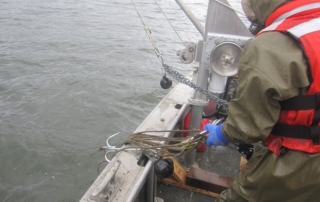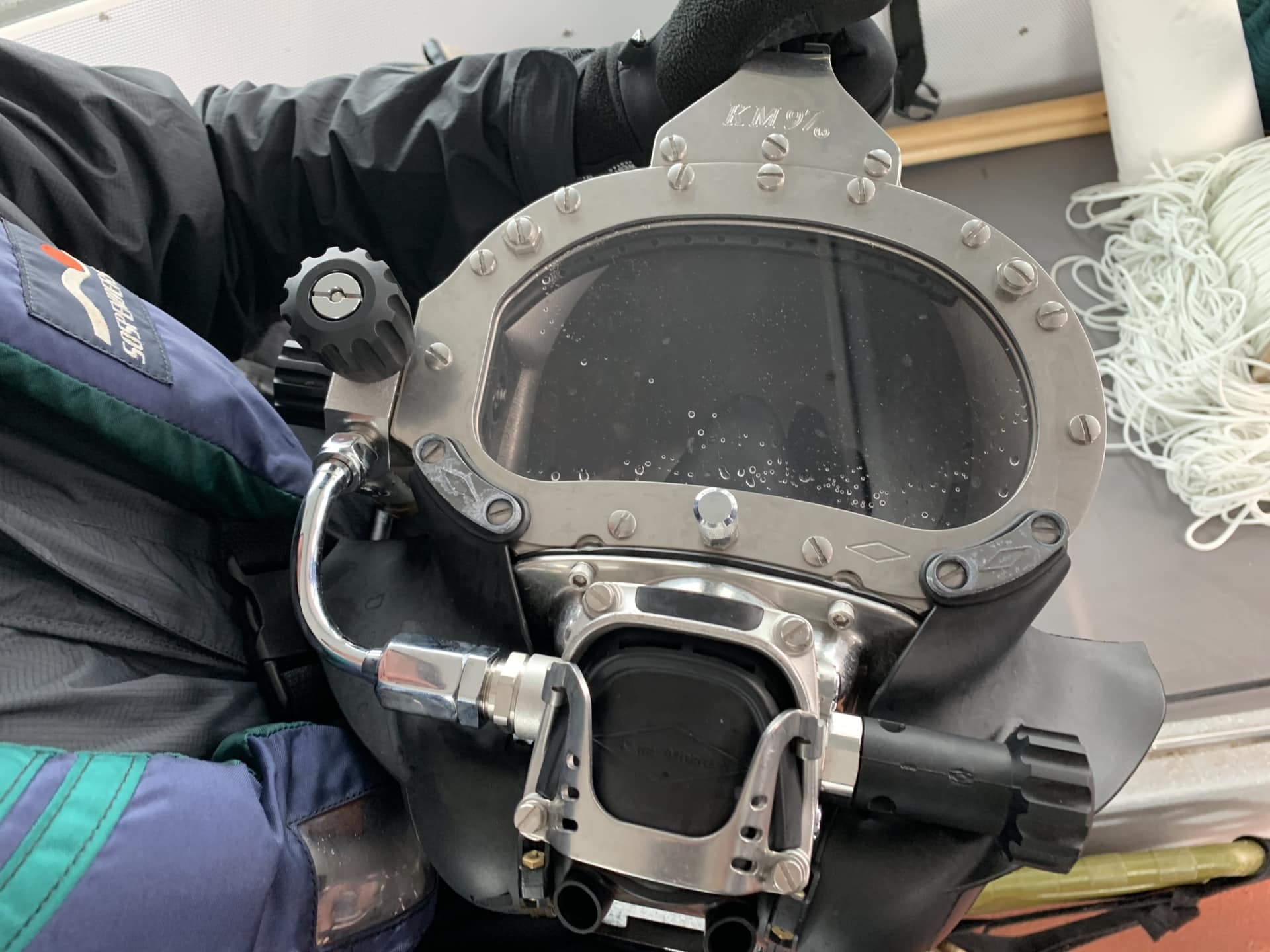REMOVED
0
DERELICT CRAB POTS
RECYCLED
0
RECREATIONAL POTS
Kamal Lindoff, Environmental Director overlooks the derelict crab pots they were able to retrieve for the day.
Study Area
Study Area Sandy Beach
Sandy Beach Study Area Known Crab Pot Area The Sandy Beach region on the west side of the Gastineau Channel (see map to the right) is historically and currently
Bernadine DeAsis, Environmental Specialist showing off a piece of a derelict crab pot.
Overview
The DIA Marine Debris Removal Project was conducted to: locate, remove and prevent accumulation of derelict crab pots from marine habitats of the Juneau marine environment, Gastineau Channel area identified as Essential Fish Habitats, including marine protected areas, Habitat Areas of Particular Concern for salmon and known distribution areas for halibut, Dungeness, Tanner and King crab.
DIA NOAA Marine Debris Removal Project
Project Plan
Marine Debris Project Plan
Sandy Beach Area Marine Debris
Kamal Lindoff, Environmental Director and Joel Webb, Alaska Fish & Game Biologist pull up a derelict crab pot.
Key Findings
Noaa Marine Debris Project Partners

This Marine Debris Project was designed and executed in partnership with:
- Natural Resources Consultants, Inc.(NRC),
- Alaska Department of Fish & Game (ADF&G),
- Fenn Enterprise, Aldrich Offshore Services, Sealaska (AFS),
- U.S. Coast Guard (USCG), Alaska State Troopers (AKST),
- Northwest Straits Foundation (NWSF)
- Funded by the NOAA Marine Debris Grant, World Animal Protection Grant, North West Straits Foundation(NWSF) and in-kind from all project partners.
For more information contact:
Kamal Lindoff, Environmental Director |
Bernadine DeAsis, Environmental Specialist |
Phone: 907-364-2916 Fax: 907-364-2917









![IMG_9179[1]](https://diataku.storage.googleapis.com/wp-content/uploads/2015/06/22001936/IMG_91791-1-320x202.jpg)
![sqdani2[1]](https://diataku.storage.googleapis.com/wp-content/uploads/2015/06/22001938/sqdani21-320x202.jpg)
![shrimppots[1]](https://diataku.storage.googleapis.com/wp-content/uploads/2015/06/22001940/shrimppots1-320x202.jpg)
![kamalpots(2)[1]](https://diataku.storage.googleapis.com/wp-content/uploads/2015/06/22001943/kamalpots2021-320x202.jpg)
![kamal_shrimppots2[1]](https://diataku.storage.googleapis.com/wp-content/uploads/2015/06/22001945/kamal_shrimppots21-320x202.jpg)
![kamal_shrimppots[2]](https://diataku.storage.googleapis.com/wp-content/uploads/2015/06/22001947/kamal_shrimppots2-320x202.jpg)
![IMG_9206[1]](https://diataku.storage.googleapis.com/wp-content/uploads/2015/06/22001949/IMG_92061-320x202.jpg)
![IMG_9203[2]](https://diataku.storage.googleapis.com/wp-content/uploads/2015/06/22001952/IMG_92032-320x202.jpg)
![IMG_9201[1]](https://diataku.storage.googleapis.com/wp-content/uploads/2015/06/22001953/IMG_92011-320x202.jpg)
![IMG_9200[1]](https://diataku.storage.googleapis.com/wp-content/uploads/2015/06/22001954/IMG_92001-320x202.jpg)
![IMG_9198[1]](https://diataku.storage.googleapis.com/wp-content/uploads/2015/06/22001959/IMG_91981-320x202.jpg)
![IMG_9195[1]](https://diataku.storage.googleapis.com/wp-content/uploads/2015/06/22002001/IMG_91951-320x202.jpg)
![IMG_9194[1]](https://diataku.storage.googleapis.com/wp-content/uploads/2015/06/22002002/IMG_91941-320x202.jpg)
![IMG_9189[1]](https://diataku.storage.googleapis.com/wp-content/uploads/2015/06/22002005/IMG_91891-320x202.jpg)
![IMG_9188[1]](https://diataku.storage.googleapis.com/wp-content/uploads/2015/06/22002006/IMG_91881-320x202.jpg)
![IMG_9184[1]](https://diataku.storage.googleapis.com/wp-content/uploads/2015/06/22002011/IMG_91841-320x202.jpg)
![IMG_9182[1]](https://diataku.storage.googleapis.com/wp-content/uploads/2015/06/22002012/IMG_91821-320x202.jpg)
![IMG_9179[1]](https://diataku.storage.googleapis.com/wp-content/uploads/2015/06/22002014/IMG_91791-320x202.jpg)
![IMG_9177[1]](https://diataku.storage.googleapis.com/wp-content/uploads/2015/06/22002016/IMG_91771-320x202.jpg)
![IMG_9175[1]](https://diataku.storage.googleapis.com/wp-content/uploads/2015/06/22002023/IMG_91751-320x202.jpg)
![IMG_9172[1]](https://diataku.storage.googleapis.com/wp-content/uploads/2015/06/22002025/IMG_91721-320x202.jpg)
![IMG_9171[2]](https://diataku.storage.googleapis.com/wp-content/uploads/2015/06/22002026/IMG_91712-320x202.jpg)
![IMG_9169[1]](https://diataku.storage.googleapis.com/wp-content/uploads/2015/06/22002028/IMG_91691-320x202.jpg)
![IMG_2979[1]](https://diataku.storage.googleapis.com/wp-content/uploads/2015/06/22002032/IMG_29791-320x202.jpg)
![IMG_2975[1]](https://diataku.storage.googleapis.com/wp-content/uploads/2015/06/22002034/IMG_29751-320x202.jpg)
![IMG_2968[1]](https://diataku.storage.googleapis.com/wp-content/uploads/2015/06/22002037/IMG_29681-320x202.jpg)
![IMG_2964[1]](https://diataku.storage.googleapis.com/wp-content/uploads/2015/06/22002039/IMG_29641-320x202.jpg)
![IMG_2963[1]](https://diataku.storage.googleapis.com/wp-content/uploads/2015/06/22002044/IMG_29631-320x202.jpg)
![IMG_2957[1]](https://diataku.storage.googleapis.com/wp-content/uploads/2015/06/22002049/IMG_29571-320x202.jpg)
![IMG_2949[1]](https://diataku.storage.googleapis.com/wp-content/uploads/2015/06/22002051/IMG_29491-320x202.jpg)
![IMG_2938[1]](https://diataku.storage.googleapis.com/wp-content/uploads/2015/06/22002053/IMG_29381-320x202.jpg)
![IMG_2934[1]](https://diataku.storage.googleapis.com/wp-content/uploads/2015/06/22002056/IMG_29341-320x202.jpg)
![greenling2[1]](https://diataku.storage.googleapis.com/wp-content/uploads/2015/06/22002058/greenling21-320x202.jpg)
![berncollabsable[2]](https://diataku.storage.googleapis.com/wp-content/uploads/2015/06/22002100/berncollabsable2-320x202.jpg)
![bern_shrimppots[1]](https://diataku.storage.googleapis.com/wp-content/uploads/2015/06/22002102/bern_shrimppots1-320x202.jpg)






Leave A Comment